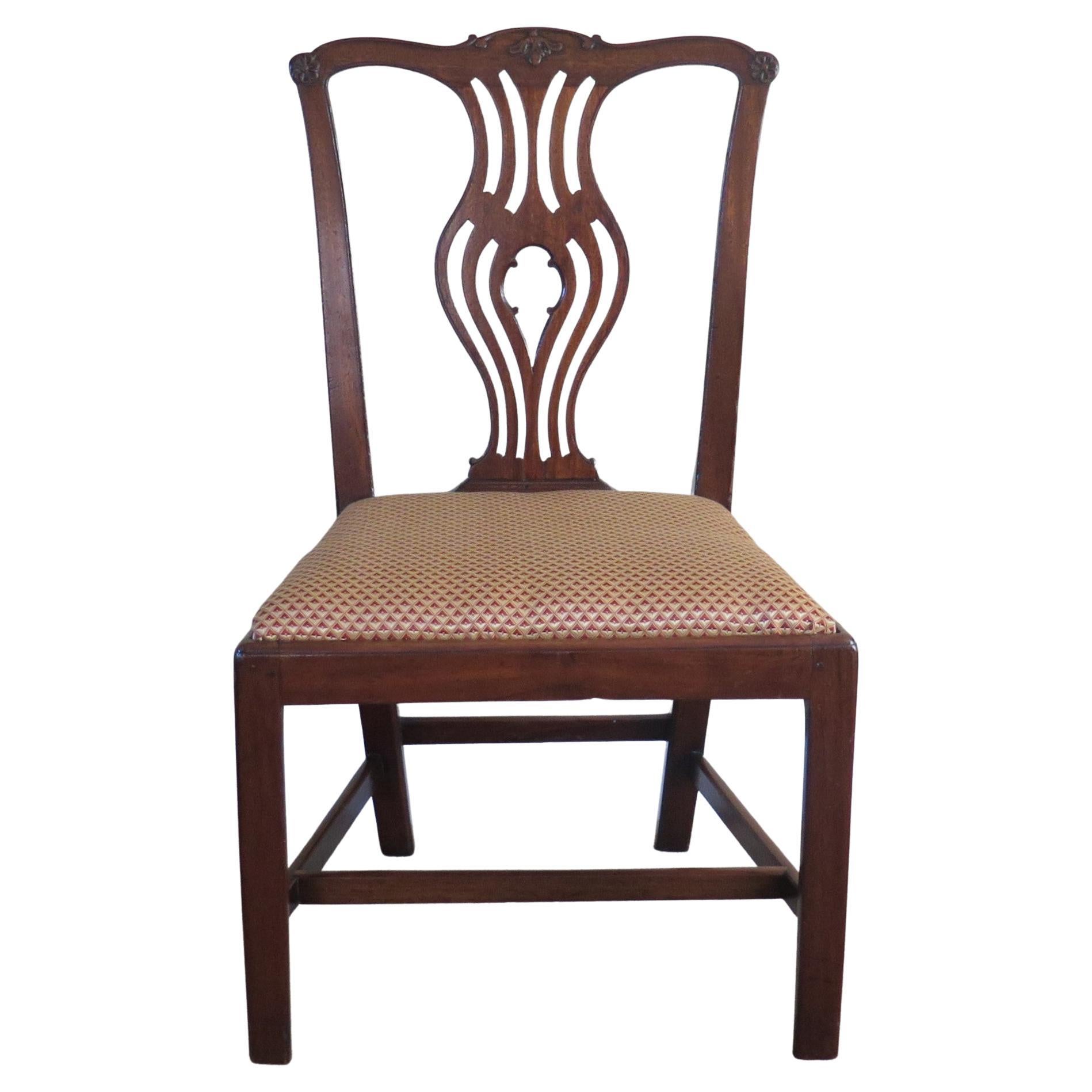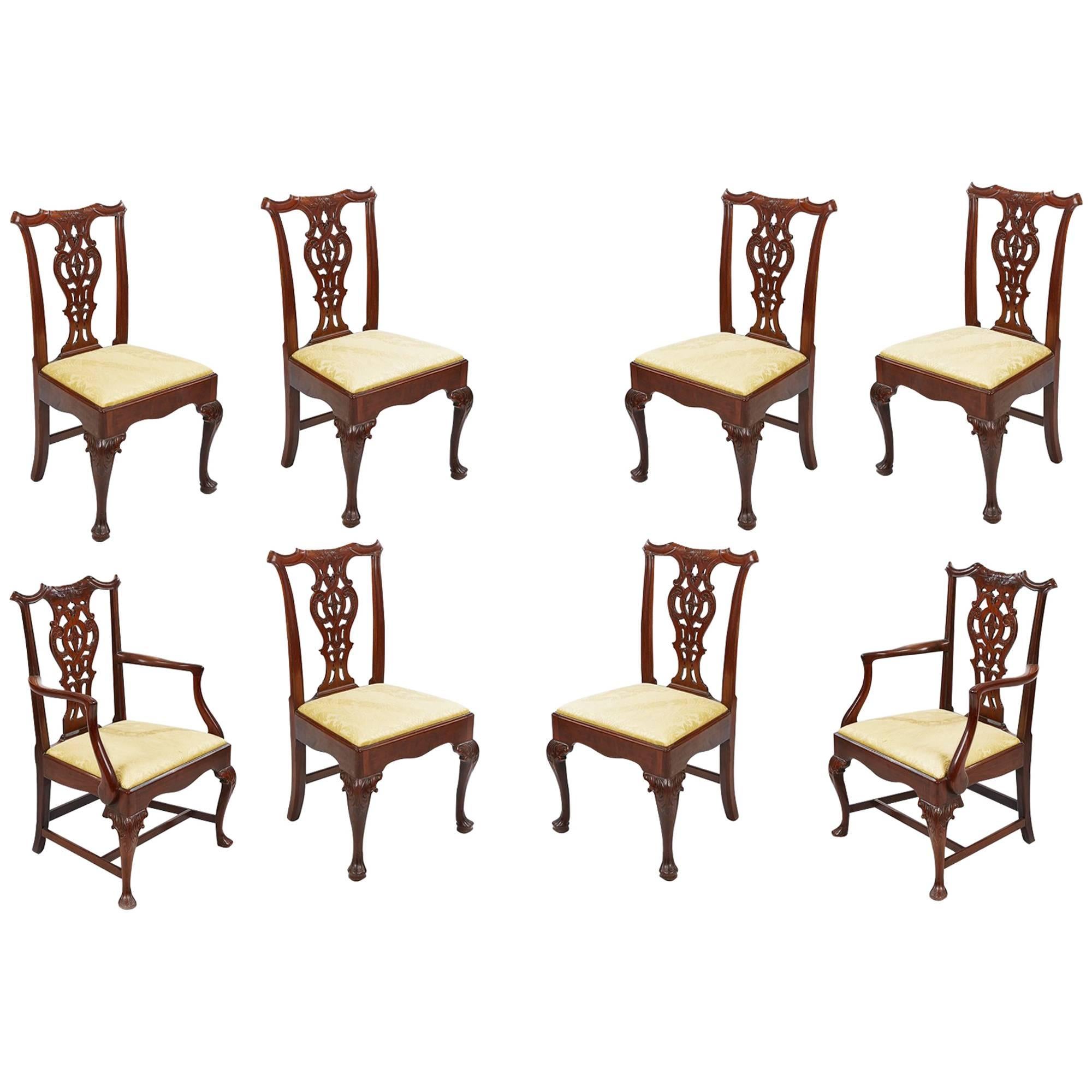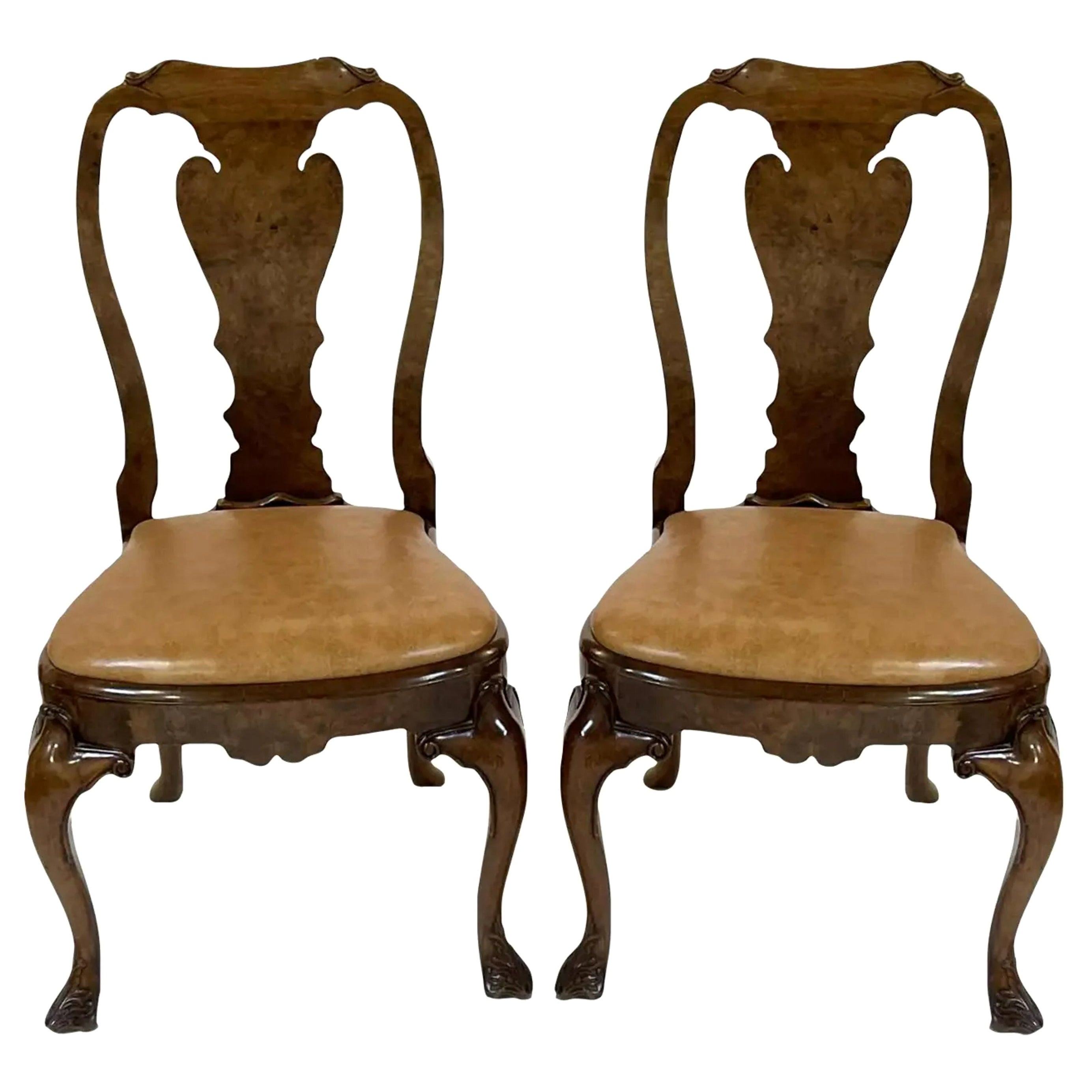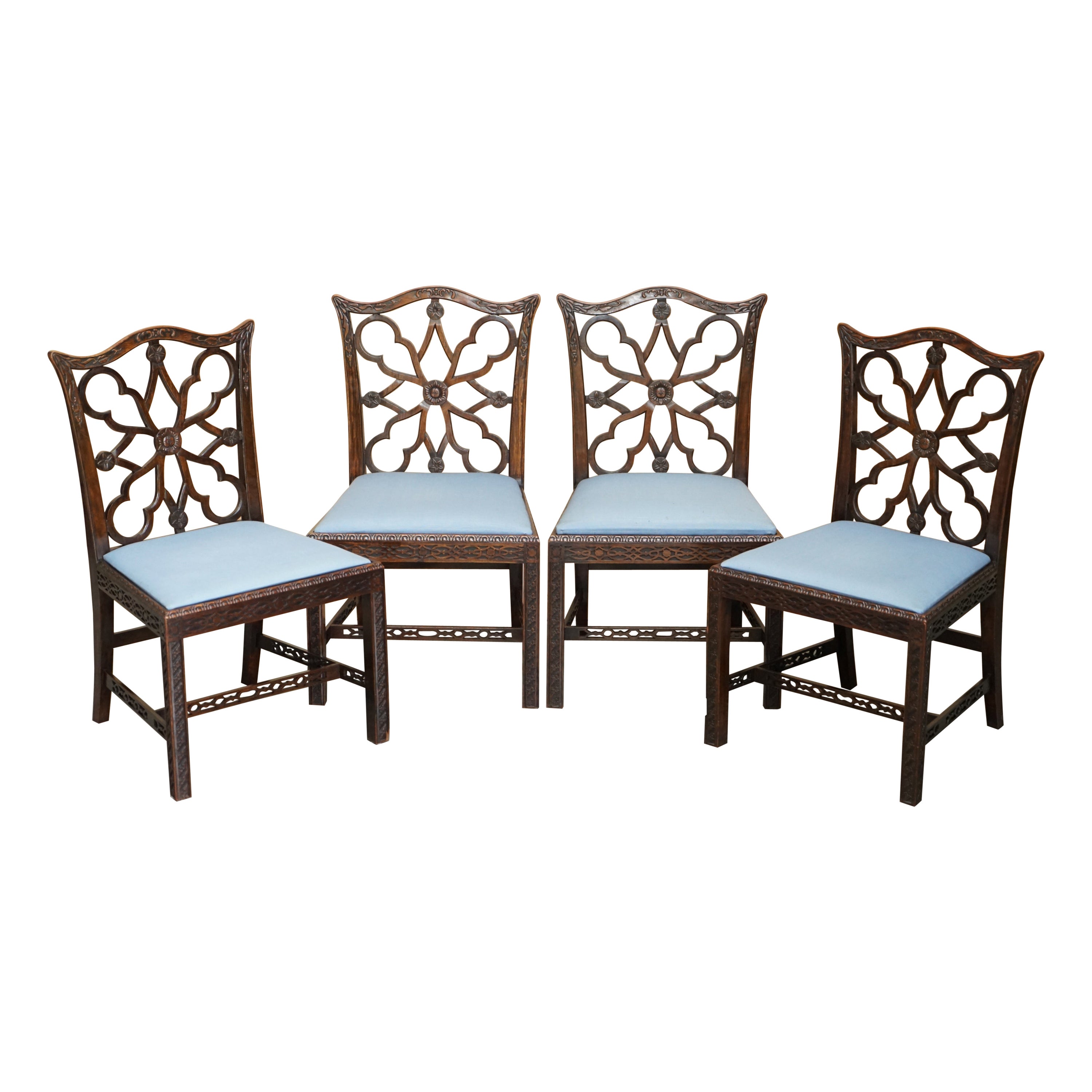Items Similar to 8 Antique George III circa 1830 Thomas Chippendale Dining Chairs William Morris
Want more images or videos?
Request additional images or videos from the seller
1 of 21
8 Antique George III circa 1830 Thomas Chippendale Dining Chairs William Morris
About the Item
We are delighted to offer this suite of eight period George III circa 1830 hand made in England Mahogany dining chairs after Thomas Chippendale with William Morris removeable seat covers
These chairs are very well made important pieces of English Georgian furniture. They are a period suite made in the correct way with dowel joints and dovetail stretchers. The six standard chairs are all the same, the pair of carvers are a his and her pair so they have slight differences to the line of the back
They have black upholstery under the antique William Morris removable covers, they are all in very good order apart from one which has worn at the front, you can still buy this fabric from Morris & Co to replace it if you wish. The seat platforms are original and in varying conditions, if I were to keep the chairs myself I would have them repadded and upholstered with a nice Georgian Damask fabric in blue in keeping with the originals by Chippendale
Condition wise, we have cleaned waxed and polished them from top to bottom, they have normal age and use related patina marks here and there as you would expect from 190+ year old pieces
Dimensions
Height:- 93.5cm
Width:- 54.5cm standard chairs, 59cm carvers
Depth:- 62.5cm
Seat height:- 47cm
Please note all measurements are taken at the widest point
This item is available for collection from our Pulborough warehouses
Condition
Please view the very detailed pictures as they form part of the description pertaining to the condition.
Please note vintage period and original items such as leather seating will always have natural patina in the form of creasing and wear, we recommend annual waxing to ensure no moisture is lost, also hand dyed leather is not recommended to sit in direct sunlight for prolonged periods of time as it will dry out and fade.
- Creator:William Morris (English) (Maker)
- Similar to:Thomas Chippendale (Cabinetmaker)
- Dimensions:Height: 36.82 in (93.5 cm)Width: 21.46 in (54.5 cm)Depth: 24.61 in (62.5 cm)Seat Height: 18.51 in (47 cm)
- Sold As:Set of 8
- Style:Georgian (Of the Period)
- Materials and Techniques:
- Place of Origin:
- Period:
- Date of Manufacture:1830
- Condition:Reupholstered. Wear consistent with age and use. Minor fading.
- Seller Location:GB
- Reference Number:1stDibs: LU2823326223532
About the Seller
4.6
Gold Seller
These expertly vetted sellers are highly rated and consistently exceed customer expectations.
Established in 2012
1stDibs seller since 2017
1,737 sales on 1stDibs
Typical response time: <1 hour
- ShippingRetrieving quote...Ships From: United Kingdom
- Return PolicyA return for this item may be initiated within 14 days of delivery.
More From This SellerView All
- Six Imporatant George III 1760 Thomas Chippendale Chinese Pagoda Dining ChairsBy Thomas ChippendaleLocated in GBWe are delighted to offer this important suite of museum quality, George III circa 1760-1765, Thomas Chippendale Chinese Pagoda top dining chairs with the original embroidered seat pads Where to begin, if you’re looking at this listing then the chances are you know exactly how significant this suite is. Thomas Chippendale was simply put, the most important furniture designer in history. A similar suite of twelve chairs with one reproduction that were attributed to Chippendale...Category
Antique 1760s English George III Dining Room Chairs
MaterialsHardwood
- SIX EXQUISITE ViNTAGE THOMAS CHIPPENDALE CHINESE PAGODA TOP DINING CHAIRSBy Thomas ChippendaleLocated in GBRoyal House Antiques We are delighted to offer this stunning suite of museum quality, George III style Thomas Chippendale Chinese Pagoda to...Category
Vintage 1940s English George III Dining Room Chairs
MaterialsUpholstery, Hardwood
- FOUR ANTIQUE COLONIAL THOMAS CHIPPENDALE HARDWOOD FRET WORK CARVED DiNING CHAIRSBy Thomas ChippendaleLocated in GBRoyal House Antiques We are delighted to offer this important suite of museum quality, antique Colonial Rosewood Thomas Chippendale, fret work carved dining chairs Please note the delivery fee listed is just a guide and covers London only for the UK and local Europe for the rest of the world, if you are outside of this area please send me your address and I will provide you with an accurate quote Where to begin, if you’re looking at this listing then the chances are you know exactly how significant this suite is, Thomas Chippendale was simply put, the most important furniture designer in history, these chairs are the only Colonial examples I have ever seen and in Rosewood no less, they weigh roughly three times more than a standard dining chair of the same style and size, they are very substantial The chairs are late 19th century circa 1880-1900, they are of course based on the original 18th century examples, the carving is exquisitely executed and the chairs look sophisticated and elegant from all angles The suite has been sympathetically restored to include a deep clean, hand condition wax and hand polish, the seat covers have been left as they are, they are ok, I can have them reupholstered for the cost price to anything the new owners wish Literature Two chairs illustrated in Tabellenbuch Holztechnik, Hamburg, 2013, p. 271. Exhibited Ten chairs on loan to Birmingham Museums circa 1985-2010 and exhibited at Aston Hall, Birmingham, where photographed in situ.. Dimensions Height:- 93cm Width:- 56cm Depth:- 53cm Seat height:- 47cm Please note all measurements are taken at the widest point. Lot Essay These chairs are closely related to those in two recognised Chippendale commissions: Sir Gilbert Heathcote (d. 1785), 3rd Baronet for Normanton Hall, Rutland and William Crichton-Dalrymple, 5th Earl of Dumfries (4th Earl of Stair, 1699-1768) for Dumfries House, Ayrshire. THE RELATED CHAIRS The chairs are of identical decoration to the set of two armchairs and ten single chairs, circa 1765, formerly at Normanton Hall (1). In 1759, Sir Gilbert Heathcote (d. 1785), 3rd Baronet, succeeded to the vast inheritance established by his grandfather, also Gilbert, 1st Baronet (1652-1733), who was reputed to be ‘the richest commoner in England’ (2). The 3rd Baronet employed both Chippendale Senior and his son, Chippendale Junior, in the furnishing of his Palladian mansion, Normanton Hall in Rutland, and his London houses, 29 Grosvenor Square, London and Browne's House at North End, Fulham. Surviving Chippendale accounts, although incomplete, show that the firm was working periodically for members of the Heathcote family from 1768 to 1821. Most of the furniture listed in these accounts was intended for Browne’s House, although after 1798 when the family relinquished this residence some of the furniture was moved to Normanton Hall. The latter was sold in 1924, and any furniture not included in the Normanton Hall sale was taken to the Earl of Ancaster’s seat at Grimsthorpe Castle, Lincolnshire. Chippendale’s earliest invoice for Sir Gilbert Heathcote records the acquisition in 1768 of ‘6 India Back and arm chairs Japand to imitate the Bamboe’, signifying how the family embraced the highly fashionable chinoiserie taste. Although the Normanton chairs cannot be conclusively identified in the extant Chippendale accounts, their form and ornamentation led Christopher Gilbert to suggest that they were possibly by Chippendale (3). The set of four mahogany chairs at Dumfries House have nearly-identical pagoda-form cresting rails and identical terminals but differ in the arrangement of the 'Chinese' paling in the backs and side panels. Although no documentary evidence for the Dumfries chairs survives, in their execution and sophisticated carving of the toprails, they are extremely close to Chippendale’s hand. Another near-set of closely related chairs is at Saltram House, Devon, where Chippendale worked between 1771-2; these dates are based on payments in John Parker's cash account book, and probably do not reflect a true picture of the entire commission as Parker often paid tradesmen by banker's draft (4). Comprising two armchairs and seven single chairs, this set, circa 1765, is made of padouk, and has been described by the National Trust as ‘Chinese Export’ (5). The set was returned to Saltram in 1951 having been accepted by H.M. Treasury in lieu of full payment of Death Duty from the Executors of Edmund Robert Parker, 4th Earl of Morley (1877-1951). Some of the chairs are currently on display in ‘The Chinese Chippendale Bedroom’. A further set of four padouk chairs of the Saltram pattern was almost certainly at Kenwood House, London; some of these are recorded in 18th century inventories drawn up by Lord Mansfield. This set was removed to Scone Palace, Perth, prior to the auction at Kenwood in 1922, and subsequently sold from ‘Scone Palace and Blairquhan: The Selected Contents of Two Great Scottish Houses’, Christie’s, London, 24 May 2007, lot 298. Another pair of padouk chairs of this model sold ‘The Collection of Peggy and David Rockefeller’, Christie’s, New York, 10 May 2018, lot 647 ($193,750 inc. premium). THE DESIGN Conceived in the Chinese manner expounded by William and John Halfpenny in Rural Architecture in the Chinese Taste (1752), and Sir William Chambers in his Designs of Chinese Buildings, Furniture, Dresses, Machines and Utensils (1757), the pattern for this set of ‘Pagoda’ chairs relates to nine designs for ‘Chinese Chairs’ in the 1st edition of Chippendale’s Director (1754); the cabinet-maker describes these designs thus: Plates XXIII, XXIV and XXV are nine Chairs in the present Chinese manner, which I hope will improve that taste, or manner of work; it having yet never arrived to any perfection; doubtless it might be lost without feeling its beauty: as it admits of the greatest variety, I think it the most useful of any other. The sizes are all specified on the designs. The three last (No. XXV.) I hope will be well received, as there has been none like them yet made. The Georgian period witnessed the proliferation of such railed and pagoda-crested chairs in both the ‘picturesque’ Chinese tea pavilions of landscaped parks as well as in fashionable apartments hung with ‘India’ paper. The geometric ‘Chinese’ feet of these chairs are also found on a set of pedestals...Category
Antique 1880s English Victorian Dining Room Chairs
MaterialsHardwood
- George III circa 1760 English Oak Thomas Chippendale Carved Bureau BookcaseBy Thomas ChippendaleLocated in GBWe are delighted to offer absolutely stunning hand made in England George III circa 1760-1780 Bureau bookcase with Thomas Chippendale carvings This is a true piece of classic Engl...Category
Antique 1760s English George III Secretaires
MaterialsOak
- 8 Antique George Hepplewhite Style Dining Chairs from Lady Diana's Spencer HouseBy George HepplewhiteLocated in GBWe are delighted to offer for sale this stunning suite of Victorian George Hepplewhite style Mahogany dining chairs from Spencer House which was built for the Spencer family between 1756-1766 for John, the first Earl Spencer, currently resides Charles Spencer the 9th Earl Spencer. I have various pieces from the last Spencer house sale, which is still owned by Lady Diana Spencer...Category
Antique 1880s English Victorian Dining Room Chairs
MaterialsHardwood
- Rare Pair of Thomas Chippendale Period 1760 Embroidered Chairs Ornately CarvedBy Thomas Chippendale, Thomas Chippendale Jr.Located in GBWe are delighted to this very rare pair of Thomas Chippendale era circa 1760 Library chairs with period embroidered upholstery These are a very rare and highly collectible pair of Library chairs, they were made in the Chippendale era and closely after his designs, the fret work carving, ornate legs, all very finely executed by a master craftsman The upholstery is all original embroidery, the colours are very much of the period and not seen on later reproduction pieces. These are an exceptional example and would be highly prized in any collection The chairs have been lightly restored to include some work to the carvings, the timber has been sympathetically French polished to ensure none of the original charm and patina has been lost A period pair of Chippendales by the great man himself (which these could be) would retail for the high hundreds of thousands, however alas Chippendales are only originals if they come with iron clad provenance, a difficult thing to keep hold of for nearly 250 years. One of the chairs has a plaque to the base for Charles Tozer of 25 Brook street London, Mr Tozer was a very well respected Antiques dealer in the early 20th to mid 20th century that specialised in 18th century furniture Dimensions: Height 97cm Width 64cm Depth 65cm Please note all measurements are taken at the widest point Thomas Chippendale (1718–1779) was born in Otley in the West Riding of Yorkshire, England in June 1718. He became a cabinet-maker in London, designing furniture in the mid-Georgian, English Rococo, and Neoclassical styles. In 1754 he published a book of his designs, titled The Gentleman and Cabinet Maker's Director, upon which success he became renowned. The designs are regarded as representing the current British fashion for furniture of that period and are now reproduced globally. He was buried 16 November 1779, according to the records of St Martin-in-the-Fields, in the cemetery since built upon by the National Gallery. Chippendale furniture is much valued; a padouk cabinet that was offered for auction during 2008 sold for £2,729,250. Life "A Design for a State Bed" from the Director, 1762. Chippendale was born the only child of John Chippendale (1690–1768), joiner, and his first wife Mary (née Drake) (1693–1729). He received an elementary education at Prince Henry's Grammar School. The Chippendale family had long been involved with the wood working trades and so he probably received his basic training from his father, though it is believed that he was also trained by Richard Wood in York, before he relocated to London. Wood later ordered eight copies of the Director. On 19 May 1748 he married Catherine Redshaw at St George's Chapel, Mayfair and they had five sons and four daughters. During 1749 Chippendale rented a modest house in Conduit Court, near Covent Garden. In 1752 he relocated to Somerset Court, off the Strand. In 1754 Chippendale relocated to 60–62 St Martin's Lane in London, where for the next 60 years the family business operated, until 1813 when his son, Thomas Chippendale (Junior), was evicted for bankruptcy. During 1754 he also began a partnership with James Rannie, a wealthy Scottish merchant, who put money into the business at the same time as Chippendale produced the first edition of the Director. Rannie and his bookkeeper, Thomas Haig, probably cared for the finances of the business. His wife, Catherine, died during 1772. After James Rannie died in 1766, Thomas Haig seems to have borrowed £2,000 from Rannie's widow, which he used to become Chippendale's partner. One of Rannie's executors, Henry Ferguson...Category
Antique 1760s English Georgian Side Chairs
MaterialsUpholstery, Hardwood
You May Also Like
- George 111 Mahogany Chippendale Dining Chair Reupholstered, Circa 1760By Thomas ChippendaleLocated in Lincoln, LincolnshireThis is a superb hardwood walnut or mahogany, Chippendale back, side or dining chair which we date to the mid 18th century, George 111rd period, circa 1760. The chair has a very well carved "Chippendale" back splat consisting of vertical interconnected ribbons with good detail. The top rail has a serpentine crest with central crisply carved detail with an acorn motif and well formed & carved ears with rosettes. The pegged and jointed legs are square with an inside chamfer back and front and the front legs are flute molded to match the side rails, with dovetailed "H" cross-stretchers. It has a drop-in seat which has been newly upholstered and webbed but could easily be upholstered in a fabric of choice. The proportion of this chair is excellent with very good width and a good rake to the backs and rear legs. The hardwood has developed a beautiful mellow colour and patina with age and polishing over the years. Overall a fine quality, English Georgian dining chair.Category
Antique Mid-18th Century English Chippendale Dining Room Chairs
MaterialsFabric, Walnut
- 19th Century Set of Eight Chippendale Style Dining ChairsBy Thomas ChippendaleLocated in Dublin 8, IE19th century set of eight (two carvers and six singles) Chippendale style dining chairs with finely carved back splat with gold upholstered drop in cushioned seat supported on cabrio...Category
Antique Early 19th Century Irish Chippendale Dining Room Chairs
MaterialsMahogany
- George III Style Burton Ching Burl Walnut Dining Chairs, 1990sLocated in LOS ANGELES, CAGeorge III Style Burton ching burl walnut dining chairs. Each features a genuine leather seat and exquisitely carved details. Additional information: ...Category
20th Century Georgian Dining Room Chairs
MaterialsWalnut
- 19th Century Pair of Chippendale Carver ChairsBy Thomas ChippendaleLocated in Dublin 8, IEPair of Chippendale-style carver chairs with drop-in needlework embroidered seats, pierced splat backs and cabriole legs terminating on simple pad feet. This pair of carvers feature ...Category
Antique 19th Century English Georgian Chairs
MaterialsMahogany, Upholstery
- Fine Set of Ten Late 19th Century Chippendale Style Dining ChairsBy Thomas ChippendaleLocated in New York, NYA fine set of ten late 19th century Chippendale style dining chairs Comprising of two arm and eight side chairs. The intertwined backs carved with roses and beautiful foliate d...Category
Antique Late 19th Century English Chippendale Dining Room Chairs
MaterialsWood
- Set of 6 Antique William IV Dining ChairsLocated in London, GBA stunning set of six original William IV period dining chairs. They were made in England, and date from around the 1830-1840’s. The quality is superb, they have beautifully carved ...Category
Antique 1840s British William IV Dining Room Chairs
MaterialsFabric, Wood
Recently Viewed
View AllMore Ways To Browse
All Chippendale
English Georgian Dining
The Chippendale Chair
Antique Dining Suite
Antique Dining Room Suite
Antique Dining Room Suites
Vintage Antique Dining Chairs
Chippendale Dining Chairs
Pair Of Antique Dining Chairs
Antique Chairs 8
His Her Chair
His Her Chairs
English Antique Dining Chairs
Antique Chippendale Chair
Chippendale Antique Chairs
Dining Room Chairs English Antique
Blue Leather Dining Chair
Used Chippendale Dining Chairs





